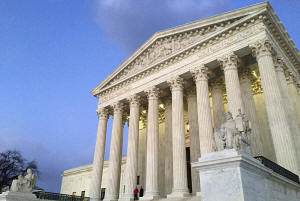Supreme Court seems intent on taking small steps in dealing with
challenges to Trump's agenda
[March 12, 2025]
By MARK SHERMAN and LINDSAY WHITEHURST
WASHINGTON (AP) — In fewer than 500 carefully chosen and somewhat opaque
words, the Supreme Court has now weighed in twice on President Donald
Trump's rapid-fire efforts to remake the federal government.
The justices did not give Trump's administration what it sought. The
court rejected the Republican administration's position that it had the
immediate power to fire the head of a watchdog office. In the other, the
court slowed the effort to block the release of up to $2 billion in
foreign aid.
In the end, the short-term losses for the administration may mean
little, and the court's actions arguably reflect less about whether
Trump was right or wrong in either case.
Instead, they may stand for an important, but less showy, commitment to
regular order from the top of a judicial system that has emerged as a
key check on Trump’s power with the Republican-controlled Congress
largely supportive or silent.
Jack Goldsmith, a Justice Department official during President George W.
Bush’s administration, said there may be benefits for the court in
taking small steps and delaying, which “brought the court advantage by
achieving emergency outcomes it wanted without having to tip its hand
prematurely on the merits of the cases.”
Trump's unparalleled flex of presidential power seems destined for
several dates at a Supreme Court that he helped shape with three
appointees during his first term.
But even a conservative majority that has a robust view of presidential
power and granted him broad immunity from criminal prosecution might
balk at some of what the president wants to do.

His push to end birthright citizenship for the children of parents who
are in the U.S. illegally, for instance, would discard more than 100
years of practice and a relatively settled understanding of the 14th
Amendment's guarantee of citizenship to “all persons born or naturalized
in the United States.”
Challenges to the citizenship order are among more than 100 lawsuits
that have been filed, and lower-court judges have hit pause on the
administration's plans more than 30 times.
The Supreme Court's early forays have largely not been about the
substance of what the president wants to do but about the procedures
used by federal judges who have the first crack at evaluating the
lawfulness of the administration's actions.
Trump allies, most notably his billionaire adviser Elon Musk, have
railed at judges slowing his agenda, threatening impeachment and
launching personal attacks. The Federal Judges Association, the largest
such organization, issued a rare public statement decrying
“irresponsible rhetoric shrouded in disinformation” that could undermine
public confidence in the judiciary.
Though Trump has said he would obey the courts, Vice President JD Vance,
Musk and others have suggested the administration could defy a court
order, which would spark a constitutional crisis. Trump has vowed to
appeal decisions he doesn't like, something his administration has done
quickly in several cases even as some plaintiffs question whether the
government is fully following judges' orders.
“It seemed to me that they're playing pretty fast and loose,” said
Jeffrey Schmitt, a professor at the University of Dayton School of Law.
“They don’t want to be seen as blatantly disrespecting the courts and
refusing to follow their orders. They also don’t want to change their
behavior.”
[to top of second column]
|

The Supreme Court at sunset in Washington, Feb. 13, 2016. (AP
Photo/Jon Elswick, File)

The Supreme Court, meanwhile, is getting drawn into the fray in fits
and starts. That could change soon, as more lawsuits reach a stage
at which they can be appealed to the high court.
“It strikes me that the court is trying to signal that the normal
processes should take place,” said Kent Greenfield, a Boston College
law professor who is the main author of a letter signed by roughly
1,000 scholars contending that the nation already is in a
constitutional crisis as a result of Trump's actions.
A progressive group, Court Accountability, said the court's more
recent order, in the foreign aid freeze case, may have been reported
as a setback for the administration.
“But a closer look at the majority’s short order reveals that the
Chief Justice actually gave Trump everything he wanted,” the group
wrote on its blog, explaining that additional delays only make it
harder for people and groups hurt by the freeze to recover.
Josh Blackman, a professor at the South Texas College of Law, wrote
on The Volokh Conspiracy blog that the high court has ducked urgent
constitutional issues it should have decided about the extent of the
president's power. Instead, he wrote, district judges “are now
confident they can issue any order they wish against the executive
branch, and the Supreme Court will not stop them. This is the
judiciary run amok.”
But while they sparked online outrage in some quarters of the
president's base, the events of the past few days could be seen as
validation for the justices' cautious approach.
On Feb. 21, a Supreme Court order temporarily kept Hampton
Dellinger, the head of the Office of Special Counsel, in his job
despite efforts by Trump to fire him.
In fact, the justices didn’t rule either way on the administration’s
request to throw out an order in Dellinger's favor. The high court
held the matter “in abeyance,” pending further proceedings in the
lower court.
On Thursday, Dellinger ended his legal fight after a federal appeals
court ruled against him — but not before he stalled the firing of
5,000 federal workers slated for layoffs.
The Supreme Court finally acted on the administration’s request,
hours after Dellinger dropped out, dismissing it as moot.

The scale of the federal layoffs that the new administration wants
to carry out could also put federal employment law in front of the
high court. While experts say the justices appear inclined to allow
the president more power to hire and fire agency heads, the outlook
is less clear for civil service protections for other federal
workers.
In the foreign aid freeze case, U.S. District Judge Amir Ali
narrowed his payment order to require the administration to
immediately pay only those organizations that had originally filed
the lawsuit.
But with nearly a dozen lawsuits filed over moves to freeze federal
funding abroad and at home so they can align spending with Trump's
agenda, the fight over “power of the purse” seems bound to return to
the Supreme Court.
The justices have played a limited role so far, but Trump's
presidency is less than two months old.
All contents © copyright 2025 Associated Press. All rights reserved |